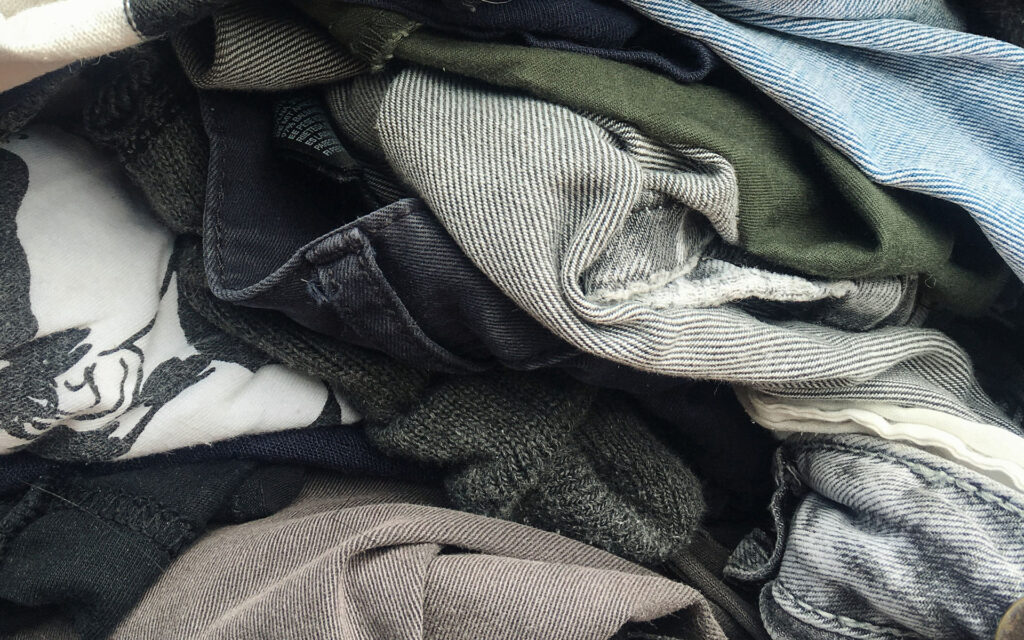The linear business model of the fashion industry, which prioritizes “take-make-throw”, results in overproduction, overconsumption, and waste generation.

The overproduction problem
Each year worldwide, the fashion industry produces between 100 billion and 150 billion garments, doubling in number since 2000.
This is encouraged by companies that produce textiles at low prices in large volumes and with fast turnover.
The more garments are ordered, the lower the individual price per garment. This allows the excess to be profitable as well, as they can be sold at a discount and still generate profits. It fuels excess production and consumption.
But increased production also leads to increased textile waste. Many materials are wasted as they cannot be used before production, and others produced are discarded soon after manufacture.
This overproduction has been accelerated by the emergence of ultra-fast fashion companies such as Boohoo, Fashion Nova, PrettyLittleThing or SHEIN. According to Business of Fashion, the latter posted more than 300,000 new garments on its website between January and April 2022.
According to the Materials Market Report 2023 presented by Textile Exchange, global fiber production increased from 112 million tons in 2021 to a record of 116 million tons in 2022, while this figure is expected to rise to 147 million tons in 2030.
Of the millions of garments produced annually, it is estimated that between 10% and 40% are not sold, generating an excess in need to be disposed of
In the case of luxury brands, the garments are destroyed to prevent them from reaching the second-hand market or being sold at a discount, negatively impacting the image of the luxury brand, which is characterized by its exclusivity.

Overconsumption and its waste
Thanks to effective advertising campaigns on social media, the fashion industry manipulates consumers to increase demand for them and its profits, generating overconsumption.
Fashion shoppers buy more than 80 billion new garments each year, which is more than 400% compared to two decades ago.
According to WRAP (Waste & Resources Action Programme) in the UK, each person buys 28 new garments a year. While Europeans use almost 26 kilograms of textile products. But many of these garments are only worn 7 to 10 times before being discarded, representing a drop of more than 35% in just 15 years.
Also, many consumers admit that they often buy clothes they never wear. According to Statista Consumer Insights, in the UK 29%, in China 12%, and in the US, 23% of women and 19% of men admit to buying clothes they discard without wearing them.
As a key fact, more than 90 million tons of textile waste are generated every year. The countries that produce the most are China with 20 million tons and the United States with 17 million tons.
The consulting firm McKinsey & Co. indicates that for every 5 garments produced, 3 of them end up incinerated or in huge landfills in countries of the Global South such as Ghana and Chile.
According to the Changing Markets Foundation, 16 out of every 21 garments from 10 fashion brands donated through its collection programs were destroyed, abandoned in warehouses, or exported to Africa, where up to half of them are quickly shredded for other uses or directly thrown away.
Circularity as a goal
One possible solution to the problem of overproduction is for companies to make products that are more durable and can be recycled.
Currently, it is estimated that less than 1% of textile waste is recycled into new garment fibers.
This is due to the large volume of garment production that neither the infrastructure nor the technology can absorb. Such a large amount of material would require recycling.
In addition, garments are often made from a mixture of different materials such as cotton and polyester, making them difficult to recycle.
Reducing production and overconsumption is the only way to meet sustainability commitments. Circular design is the way to make a positive impact on the fashion industry.
Without urgent action, the industry’s global emissions will increase by 50% by 2030 without achieving the SDGs.
By 2024, sustainability compliance will no longer be an option but an obligation. Legislation will be implemented around the world requiring companies to make changes in textile production.
As part of the plan to achieve a circular economy by 2050, to address the impact on the environment, the European Union wants to reduce textile waste and increase the life cycle and recycling of textile products.
Under the waste directive adopted by the Parliament in 2018, EU countries are obliged to collect textiles separately by 2025.
This new strategy also includes measures to address the presence of hazardous chemicals. It holds producers accountable throughout the value chain, including when they become waste. Helps consumers choose sustainable textiles.





